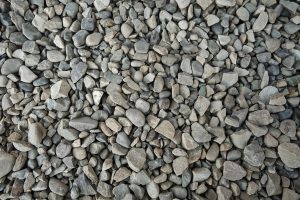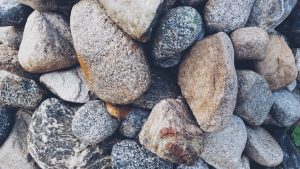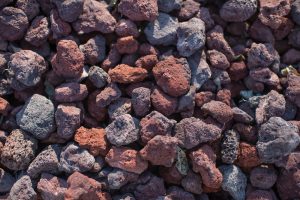Types Of Rocks For Landscaping

What are the most commonly used landscaping rocks today? Let’s look at a few!
Decomposed Granite
Typically coming with a reddish-tan coloring, decomposed granite will give your landscape design a soft and rustic feel. It is extremely popular due to its low cost, and is usually found around trails and trees.
Benefits Of Using Decomposed Granite:
- Affordable.
- Versatile.
- Helps With Drainage.
River Rock
River rocks are commonly utilized for big and small landscaping projects. Homeowners love these rocks for their smooth texture and size. These rocks are much bigger than pea gravel, which helps create beautiful garden surroundings or dry creek beds. Others may choose river rocks for an aesthetically pleasing pathway used to direct drainage.
Benefits Of Using River Rock:
- Limits Soil Erosion.
- Naturally Deter Weeds.
- Natural Substance.

Flagstone
Many landscaping projects will call for smaller pebbles. Meanwhile, other projects will need the use of larger rocks like flagstone. These rocks are ideal as stepping stones, walkways and garden paths. Think of flagstone as a great supporting cast for your lawn.
Benefits Of Using Flagstone:
- No Maintenance Needs.
- Extremely Durable.
- Turf And Moss Can Be Planted Around Flagstone.
Brick Chips
While not technically a rock, brick chips are still a popular choice for hardscapes. These rocks are comprised of crushed fragments of bricks that come in brown and reddish hues. Most individuals choose to use brick chips for path and driveways.
Benefits Of Using Brick Chips:
- Substitute For Organic Mulch.
- No Need To Replace Them.
- Durable.
Marble Chips
Marble is no longer just for use in the kitchen. Marble chips are now common for covering soil around other landscape design elements. One downside is you should not use marble chips around plants that require high levels of acid.
Benefits Of Using Marble Chips:
- Gets Warmer Than Organic Mulch.
- Won’t Blow Away Like Other Mulch Materials.
- Does Not Need To Be Replaced.
Lava Rock
Composed of real lava from volcanoes, lava rock features bold colors that will be sure to stand out. Lava rocks provide a beautiful accent to any landscaping designs. Ideal for dry climates, lava rocks can absorb heat well during the day, releasing it at night.
Benefits Of Using Lava Rock:
- Lightweight.
- Protects The Soil.
- Porous.

Crushed Granite Gravel
Crushed granite gravel comes with larger particles than decomposed granite. Use this gravel to create a scenic walkway from garden to home.
Benefits Of Using Crushed Granite Gravel:
- Affordable.
- Soft And Natural Look.
- Drains Efficiently.
Pea Gravel
Only up to 1/8-inch in size, pea gravel can be white, tan or brown, meaning it can be used in multiple areas. Often, pea gravel covers driveways or fills in gaps.
Benefits Of Using Pea Gravel:
- Doesn’t Decompose Like Mulch.
- Easy To Install.
- Will Prevent Erosion.
Cactus For Sale In Arizona
If you are interested in increasing the beauty of your landscape by buying desert plants, stop by our convenient location at 33840 N. Cave Creek Rd., in Cave Creek. For customers interested in our landscaping services, give us a call at (480) 488-9455 to schedule a visit to your home.
More Articles About Xeriscaping
- Tips For Growing Indoor Cactus
- Wood Chips Vs Mulch
- Desert Landscaping Ideas
- 10 Incredible Saguaro Cactus Facts
- Where To Buy Saguaro Cactus
- How To Save A Dying Cactus
- How To Bring A Dead Palm Tree Back To Life
- Landscaping Prices In Arizona
- Landscape Boulders Cost
- How To Take Care Of A Cactus In Arizona | Gardening Tips
- Desert Shrubs
- When are the Saguaro Cactus in Bloom in AZ?
- Mulch vs Compost | Differences
- Garden Soil Vs. Potting Mix | Differences
- What Type Of Water Fountain Should I Buy?
- What is Xeriscape?
- The Benefits of Ground Covering Plants
- Desert Plants
- Common Desert Plants Found in Arizona
- Garden Water Fountains
- Types of Cactus
- Different Types of Water Fountains for Your Garden
- Desert Landscaping Phoenix
- Sonoran Desert Landscape Rocks
- Arizona Xeriscape Gardening


One thought on “Types Of Rocks For Landscaping”